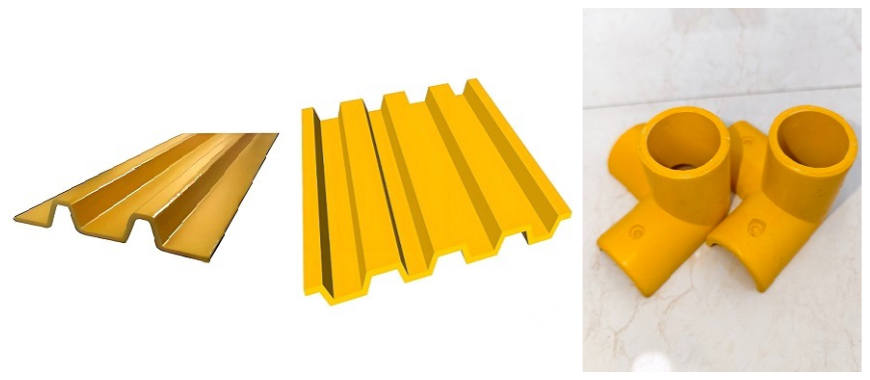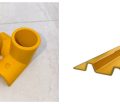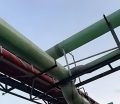
Basalt FRP is emerging as a revolutionary material in construction and engineering. Derived from volcanic rock, it offers remarkable strength and durability. Unlike traditional materials, basalt FRP is lightweight, making it easier to handle and install. Its resistance to corrosion makes it ideal for use in harsh environments. Additionally, basalt FRP maintains the same thermal expansion coefficient as concrete, enhancing structural integrity. The cost-effectiveness of basalt FRP compared to steel rebar has drawn significant attention. As more industries recognize its advantages, the demand for basalt FRP continues to grow. This article will explore the many benefits and applications of basalt FRP in modern building systems.
What is Basalt FRP?
Definition and Composition
Basalt FRP is a composite material made from volcanic rock. Its unique properties make it suitable for various applications in construction and engineering. The fibers in basalt FRP provide exceptional tensile strength. This material is non-corrosive, lightweight, and resistant to chemical attacks. These characteristics differentiate basalt FRP from traditional reinforcement materials like steel and fiberglass.
Advantages of Basalt FRP
Basalt FRP offers numerous advantages over conventional materials. Here is a comparison of basalt FRP and traditional reinforcement:
| Feature | Basalt FRP | Steel Rebar |
|---|---|---|
| Weight | Lightweight and easy to handle | Heavier, requiring more labor |
| Corrosion Resistance | Naturally resistant to corrosion | Prone to rust and requires coatings |
| Tensile Strength | Higher tensile strength | Moderate tensile strength |
| Thermal Expansion | Matches concrete expansion | Different expansion properties |
| Moisture Penetration | Does not spall due to moisture | Can spall and degrade |
| Cost-Effectiveness | Generally lower long-term costs | Higher maintenance costs |
Basalt FRP provides advantages in various environments, especially where corrosion is a concern. Its lightweight nature simplifies installation, reducing labor costs. Additionally, basalt FRP’s compatibility with concrete makes it ideal for modern construction methods.
However, there are some considerations when using basalt FRP. Potential drawbacks include the initial cost of materials and limited supplier availability. Ongoing research continues to explore its long-term performance in different applications. Real-world examples include its use in bridges, foundations, and swimming pool construction, showcasing its versatility and reliability.
Top Advantages of Using FRP Grating Material Today
Cost and Pricing of Basalt FRP
Basalt FRP Price Overview
The price of basalt FRP is influenced by several key factors. Understanding these factors helps determine the overall cost of projects using this material. Basalt FRP typically costs more than traditional materials initially, but its long-term benefits can offset this investment.
Key factors affecting basalt FRP pricing include:
- Raw Material Availability: The availability of volcanic rock impacts production costs.
- Manufacturing Processes: Advanced manufacturing techniques can raise production expenses.
- Shipping Costs: Transportation fees vary depending on the distance from suppliers.
- Market Demand: Increased demand for basalt FRP can lead to price fluctuations.
- Competition: The presence of alternative materials influences pricing dynamics.
As the market for basalt FRP expands, prices may stabilize or decrease. Research into more efficient manufacturing methods could also help reduce costs in the future. Overall, while the initial price of basalt FRP may seem high, its durability and low maintenance requirements make it a cost-effective choice over time.
Factors Affecting Basalt FRP Cost
Several factors contribute to the overall cost of basalt FRP, influencing both production and market prices. Analyzing these factors can provide insights into future pricing trends.
- Production Techniques: Advances in production technology can lower costs by increasing efficiency. Improved techniques may lead to greater output with fewer resources.
- Supply Chain Dynamics: The efficiency of the supply chain affects the final price of basalt FRP. A streamlined process can minimize shipping and handling costs.
- Market Competition: As more manufacturers enter the basalt FRP market, competition can drive prices down. Increased availability encourages wider use of this material.
- Research and Development: Ongoing research into basalt FRP properties and applications can lead to innovations that improve its cost-effectiveness. Development of new products may attract more customers.
- Environmental Regulations: Compliance with environmental regulations may impact production costs. Sustainable practices could lead to additional expenses, but they may also enhance the appeal of basalt FRP.
The evolving landscape of construction materials will continue to shape the cost of basalt FRP. Its unique properties and advantages make it an attractive option for many projects, despite initial pricing considerations. As awareness of its benefits grows, demand for basalt FRP is expected to rise, potentially influencing its cost in the long term.
Availability and Sourcing of Basalt FRP
Where to Find Basalt FRP for Sale
Sourcing basalt FRP products involves understanding the market and its distribution channels. Buyers should consider several factors when looking for suppliers.
- Local Distributors: Many regions have local distributors specializing in composite materials, including basalt FRP. These distributors often provide personalized service and quicker delivery.
- Online Platforms: Numerous online marketplaces list basalt FRP products for sale. Buyers can compare prices and specifications conveniently.
- Trade Shows and Expos: Industry events provide opportunities to meet suppliers and see products firsthand. These gatherings often showcase the latest advancements in basalt FRP technology.
- Networking: Engaging with professionals in the construction and engineering sectors can yield valuable recommendations for reliable suppliers of basalt FRP.
- Research and Development Institutions: Some universities and research centers collaborate with manufacturers, offering insights into where to source high-quality basalt FRP products.
Effective sourcing ensures that projects receive reliable materials that meet industry standards. As the demand for basalt FRP increases, more suppliers may enter the market, enhancing availability.
Basalt FRP Suppliers and Manufacturers
Identifying reputable basalt FRP suppliers and manufacturers is crucial for ensuring quality. A reliable supplier can impact project outcomes significantly. Here are some key points regarding suppliers:
- Established Companies: Look for manufacturers with a strong track record in producing basalt FRP. Longevity in the market often indicates reliability and quality.
- Certifications: Suppliers should have the necessary certifications to ensure their products meet safety and performance standards. Certifications help validate the quality of basalt FRP.
- Customer Reviews: Checking customer testimonials and reviews can provide insights into supplier reliability and product performance.
- Technical Support: Reputable suppliers often offer technical support, helping customers choose the right basalt FRP products for their specific needs.
- Innovation: Manufacturers engaged in research and development may provide advanced basalt FRP solutions, incorporating the latest technology and materials.
Building a relationship with a trusted supplier can lead to better pricing and support for future projects involving basalt FRP.
Products Made from Basalt FRP
Basalt FRP is versatile and comes in various forms, making it suitable for numerous applications. Here’s an overview of the products available:
- Basalt FRP Rebar: This is the most common application, providing a strong, lightweight alternative to traditional steel rebar. Its corrosion resistance makes it ideal for challenging environments.
- Basalt FRP Mesh: Used for strengthening concrete structures, basalt FRP mesh offers excellent tensile strength and flexibility. It is particularly useful in repair and retrofitting projects.
- Basalt FRP Fabrics: These fabrics can be used for wrapping columns, beams, and other structural elements to enhance load-bearing capacity.
- Basalt FRP Sheets: Sheets made from basalt FRP can be used in a variety of applications, including wall panels and flooring systems.
- Basalt FRP Tapes: Useful for reinforcing joints and seams, basalt FRP tapes provide additional strength where needed.
- Basalt Chopped Fiber: This product is often mixed with other materials to enhance their properties, providing added strength and durability.
The wide range of basalt FRP products ensures that various construction needs can be met effectively. As research continues, new applications for basalt FRP may emerge, further expanding its use in the industry.
How FRP Liquid Enhances Fiberglass Reinforced Applications
Applications of Basalt FRP
Common Uses of Basalt FRP
Basalt FRP has a wide range of applications in construction and engineering. Its unique properties make it suitable for various projects where strength and durability are essential. Here are some common uses of basalt FRP:
- Reinforcement in Concrete Structures: Basalt FRP rebar is widely used in concrete structures. Its high tensile strength enhances the load-bearing capacity of beams and slabs.
- Repair and Retrofitting: Basalt FRP can strengthen existing structures. Engineers often use it to reinforce aging bridges, buildings, and dams, extending their lifespan.
- Infrastructure Projects: Many infrastructure projects utilize basalt FRP due to its corrosion resistance. It is ideal for applications in highways, railways, and tunnels.
- Swimming Pools: Basalt FRP is used in the construction of swimming pools. Its resistance to chemicals and moisture makes it an excellent choice for this environment.
- Architectural Elements: Designers incorporate basalt FRP in aesthetic architectural features. It can be molded into various shapes and sizes for creative designs.
- Historical Restoration: In restoration projects, basalt FRP is often used to preserve historical buildings. Its compatibility with traditional materials ensures structural integrity without compromising aesthetics.
These applications highlight the versatility of basalt FRP in modern construction and renovation efforts. The material’s performance in various environments showcases its adaptability and effectiveness.
Benefits in Specific Environments
Basalt FRP excels in specific environments, particularly where traditional materials may struggle. Understanding these advantages can inform material selection in various projects.
- Marine Environments:
- Basalt FRP is naturally resistant to saltwater corrosion. This makes it ideal for applications such as docks, piers, and coastal structures.
- Its lightweight nature facilitates easier handling and installation in marine settings, reducing labor costs.
- Chemical Plants:
- The resistance of basalt FRP to harsh chemicals ensures its longevity in chemical processing environments. This minimizes maintenance and replacement needs.
- Engineers often select basalt FRP for tanks, piping, and containment structures, where durability is crucial.
- Extreme Weather Conditions:
- Basalt FRP performs well in extreme temperature variations. Its thermal expansion properties match those of concrete, reducing the risk of cracking.
- In regions with high humidity, basalt FRP’s moisture resistance prevents spalling and degradation.
- Infrastructure Resilience:
- Basalt FRP enhances the resilience of infrastructure against natural disasters. Its strength helps structures withstand earthquakes, floods, and high winds.
- Case studies show that buildings reinforced with basalt FRP performed better during seismic events compared to those with traditional materials.
- Cost-Effectiveness:
- Despite a higher initial cost, the long-term benefits of basalt FRP in corrosive and harsh environments often lead to significant savings. Reduced maintenance and longer lifespans contribute to its cost-effectiveness.
The unique properties of basalt FRP provide substantial advantages in specific environments, making it a preferred choice for many engineers and architects. Its versatility continues to be explored in ongoing research and development efforts, further expanding its applications in the construction industry.
Future Trends in Advanced FRP: Shaping Tomorrow’s
The Promise of Basalt FRP in Modern Construction
The Future of Basalt FRP in Construction
Basalt FRP holds significant potential for the future of construction. Its unique properties offer many advantages over traditional materials. As the industry evolves, basalt FRP can become a staple in various applications.
Key benefits of basalt FRP include:
- Durability: Basalt FRP is highly resistant to corrosion and chemical attacks. This durability makes it suitable for long-lasting structures in harsh environments.
- Lightweight: The lightweight nature of basalt FRP simplifies handling and installation. Reduced labor costs and easier logistics are major advantages.
- Strength: With a higher tensile strength than steel, basalt FRP enhances the structural integrity of various projects. This strength allows for thinner designs and innovative architectural solutions.
- Compatibility with Concrete: Basalt FRP shares a similar thermal expansion coefficient with concrete. This compatibility reduces the risk of cracking and other structural issues.
- Sustainability: As a natural material, basalt FRP is more environmentally friendly than many synthetic options. Its use can lead to more sustainable construction practices.
The growing awareness of these benefits has led to increased interest in basalt FRP among engineers and architects. Research continues to explore new applications and improve manufacturing processes.
Challenges still exist, such as initial costs and limited supplier options. However, ongoing developments aim to address these issues, enhancing the accessibility of basalt FRP products.
Basalt FRP offers a promising alternative to traditional materials in modern construction. Its durability, strength, and sustainability make it a valuable resource for the future. As the industry embraces innovative materials, basalt FRP is poised to play a significant role in shaping resilient and efficient building systems.
FAQs about Basalt FRP
Basalt FRP, or fiber-reinforced polymer, is made from volcanic rock. This composite material is known for its high tensile strength and durability. Basalt FRP is used primarily in construction and engineering applications. It offers excellent resistance to corrosion and chemical attacks, making it suitable for harsh environments. The production process involves extracting basalt fibers, which are then combined with a polymer matrix. The result is a lightweight, strong material that can replace traditional steel reinforcement. Basalt FRP is gaining popularity due to its unique properties and sustainability. It has the same thermal expansion coefficient as concrete, reducing risks of cracking. Overall, basalt FRP is an innovative solution for modern construction challenges.
Basalt fiber rebar has several advantages over steel rebar. First, it is significantly lighter, making it easier to handle and transport. This lightweight characteristic reduces labor costs during installation. Additionally, basalt fiber rebar does not corrode, unlike steel. This corrosion resistance leads to lower maintenance costs and longer service life. While the initial cost of basalt fiber rebar may be higher, its long-term benefits often justify the investment. Basalt fiber rebar also has a higher tensile strength than traditional steel. This increased strength allows for thinner designs in concrete structures. However, some applications may still favor steel due to established practices and availability. Overall, basalt fiber rebar offers a compelling alternative for various construction needs.
Basalt fiber and carbon fiber have different properties and applications. While both materials offer high strength, their performance varies based on the context. Basalt fiber has a high tensile strength, but carbon fiber typically excels in lightweight applications. Carbon fiber is often preferred in aerospace and high-performance sports equipment due to its superior strength-to-weight ratio. However, basalt fiber is more cost-effective and environmentally friendly. It provides excellent performance in construction and infrastructure projects, especially in corrosive environments. The choice between basalt fiber and carbon fiber ultimately depends on the specific requirements of the project. For many construction applications, basalt fiber offers a strong and durable solution.
Yes, basalt fiber is considered safe for use in various applications. It is made from natural volcanic rock, which poses minimal health risks. Unlike some synthetic fibers, basalt fiber does not release harmful substances during production or use. The material is non-toxic and environmentally friendly, making it suitable for sustainable building practices. Basalt fiber also exhibits good thermal stability, reducing fire hazards in construction. Additionally, it does not produce any harmful emissions during its lifecycle. Regulatory bodies generally recognize basalt fiber as safe for use in construction and engineering. Overall, its safety and environmental benefits contribute to its growing popularity in the industry.

As the editor of GangLong Fiberglass, I have years of experience and in-depth research, focusing on cable tray products, fiberglass solutions, and grille systems. I incorporate years of industry insights and practical experience into every content, committed to promoting the progress of the industry. At GangLong Fiberglass, my commitment is reflected in every product, from innovative cable trays to durable fiberglass solutions and sturdy grille systems. As an authoritative voice in the industry, my goal is to provide valuable information to professionals and businesses and promote forward-looking solutions.


